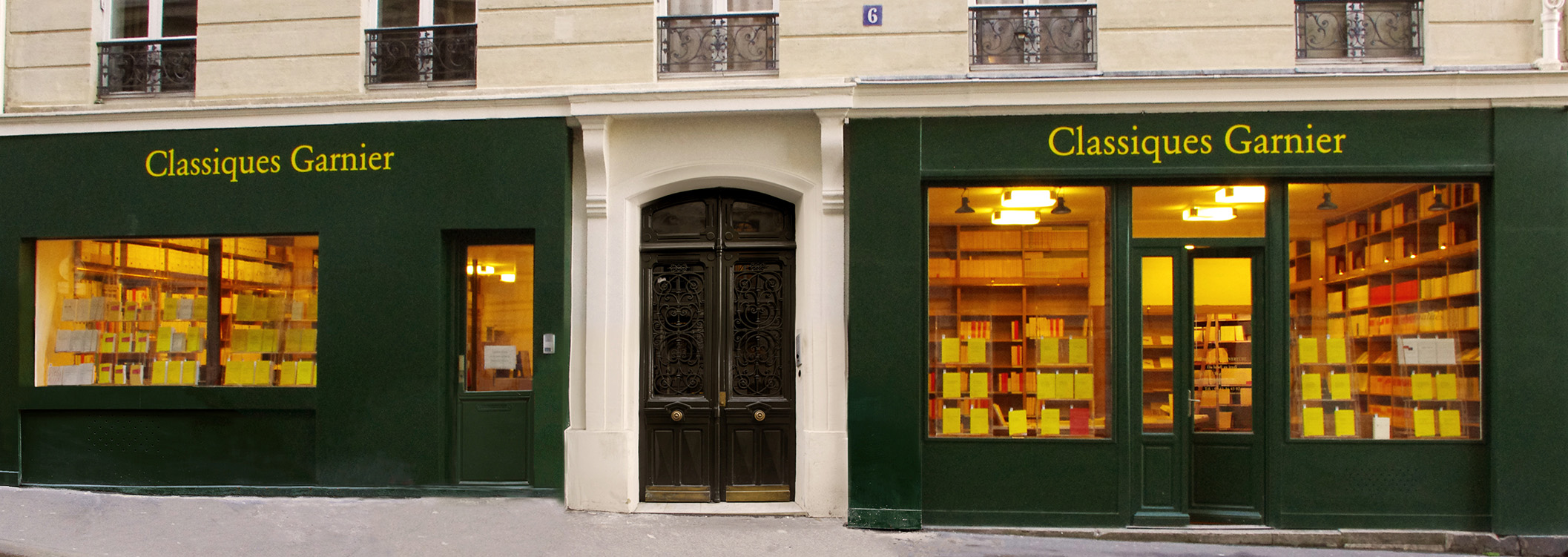News for the week of October 19
- How patient are people?
- The Bulletin is online!
- The Myth of Chopin
- General correspondence (volume VII) by Alexandre Dumas
- Poetics of space in the work of André Gide
- The Narrative Condition
- Poetics of drama, drama of poetics
- Bibliography of French literature 2022
- Constellation Cendrars, n° 7
- Available again
News for the week of October 12
- Sodis opens its doors to us
- Joan of Arc by Charles Péguy
- On the French-speaking world and their literature
- The pleasure of reading novels
- “The Path of Example” - Eroticism in 16th century Spanish literature
- In Pocket
- On the magazine side
- Available again
News for the week of October 5
- Hospitality put to the test
- The origins of the art market
- Léon Bloy one hundred years later
- Comedy in the light of law
- The Paradoxical Materialists
- Marginal figures
- Bulletin of the International Society of Friends of Montaigne
- Available again
Subscribe to our newsletter and receive, every week, all our news.
2024
2023
2022
2021
2020
2019
2018
2017
2016
2015
2014
2013
Nicolas BAREÏT au Château de Cerisy
Du lundi 19 août au dimanche 25 août 2024 - Cerisy-la-Salle
Colloque
INFOS PRATIQUES
Centre Culturel International de Cerisy
Association des Amis de Pontigny-Cerisy
2, Le Château
50210 Cerisy-la-Salle
Ouvrage en lien : Agatha Christie. Le droit apprivoisé
Clive Thomson et Michael Rosenfeld au colloque Nineteenth Century French Studies
Du 19 au 21 septembre 2024, Duke University (Caroline du Nord).
Colloque
INFOS PRATIQUES
NCFS 2024
Duke University à Durham, Caroline du Nord, États-Unis
Au Washington Duke Inn
Ouvrage en lien : Correspondance croisée 1869-1873
1833: The beginning. Under the arches of the Palais Royal
In 1833, two brothers from the department of Manche, Auguste and Hippolyte Garnier, opened a bookstore in the tradition of nineteenth-century publisher-booksellers under the arches of the Palais Royal in Paris, then one of the liveliest centers in the capital. They were soon joined by another of their brothers, Pierre. The business took off very quickly and the Garnier brothers bought up the backlists of Delloye, Dubochet, and Salvat, publishers of the works of the great romantic authors, followed by the classical lists of Panckoucke. They also struck up connections with Sainte-Beuve, Musset, Gautier, Sand, and Vigny, publishing some of their works.
1853. Settling rue des Saints-Pères
The Maison Garnier Frères gained even more prestige in 1853 when it moved to the former government building on the corner of the rue de Lille and the rue des Saints-Pères. The Garnier brothers worked to expand and improve their catalog, publishing numerous dictionaries, popular titles, and books for young readers, while also continuing with their literary publications: collections of Latin and Greek classics and modern works (such as Sainte-Beuve’s Causeries du lundi, Grimm’s Correspondance and Chateaubriand’s Œuvres complètes).
1896. The first “Classiques Garnier”
1896 saw the appearance of the first of the “Classiques Garnier,” a new collection combining the previous “Classiques latins” [Latin Classics], Classiques grecs” [Greek Classics] and “Bibliothèque choisie” [Selected Library] collections. In the words of the catalog, the new collection offered “the best French and foreign, ancient and modern works at reasonable prices.” It was a success and frequent references to the “Classiques Garnier” featured in autobiographical works thereafter.
Jean Giono, for instance, recalled how he would be given two francs every Sunday and while “works by Anatole France cost three francs fifty at Calmann-Lévy, Euripides, Aeschylus, Sophocles, Aristophanes, and Virgil were ninety-five centimes in Classiques Garnier. With my two francs I could have two of those chaps and have two centimes change. With those two centimes I could buy a stamp for my letter, because there weren’t any bookstores in Manosque and I ordered books straight from Paris. There must be a whole stack of those letters from me at Garnier from 1911 up to the war of 1914.” (Jean Giono, De Homère à Machiavel).
From “Garnier Frères” to “Classiques Garnier”
Yellow was used for the covers from the very start: at first it was a yellow paper that was sometimes more ochre or beige, then it was paper printed in yellow. With the advent of cover illustrations in the 1960s (first in the form of dust jackets) and lamination, the yellow became brighter and more luminous: the Garnier yellow everyone knows.
Over the course of the twentieth century, scholarly editions increasingly took precedence over those that were more modestly priced, to the point where a deal was struck with Flammarion in the 1960s allowing them to produce low-cost versions of the “Classiques Garnier” that were stripped of critical commentary. This was the start of Garnier-Flammarion, which became an independent company in 1970 under the name GF Flammarion.
When Éditions Garnier Frères went bankrupt in June 1983, their list was bought up by Presses de la Cité. The “yellow” collection then comprised some two hundred titles governed by editorial policies that remain practically unchanged to this day:
- a catalog consisting of core works of the great literatures of Europe;
- editions endorsed by leading specialists;
- faultless preparation of texts;
- first-class critical commentary;
- clear and careful presentation.
InfoMédia acquired the collection in 1998 with the prime aim of upholding the editorial policies that have made the “Classiques Garnier” famous for over a century.
Today
Since 2009, under the editorial direction of Claude Blum, Editions Classiques Garnier has expanded its catalog to include all aspects of literature and the humanities, publishing both editions of texts and studies and essays by top specialists in French literature, foreign literature, linguistics, history, art, music, law, economics and social sciences. Classiques Garnier publishes its titles in three formats and platforms: large, digital and paperback.
The Classiques Garnier bookstore, located 6 rue de la Sorbonne in Paris, opened in 2011. It is a meeting place where the latest publications are displayed.

The Classiques Garnier bookstore in Paris.